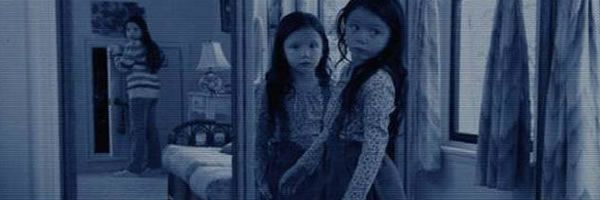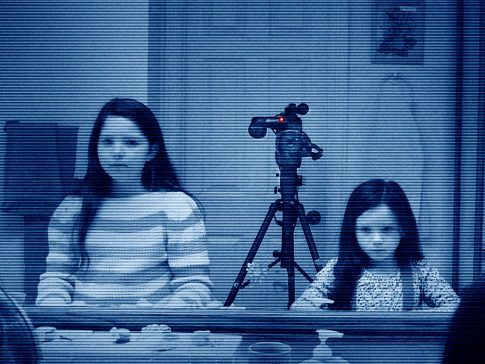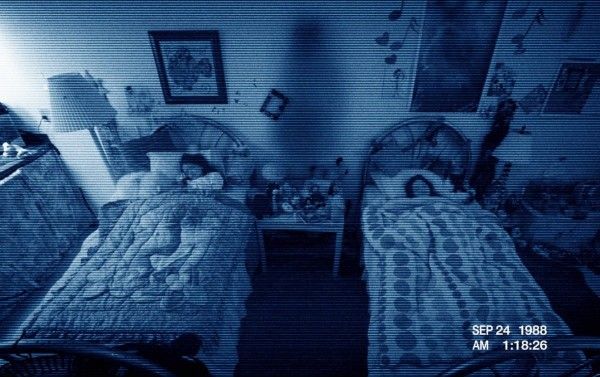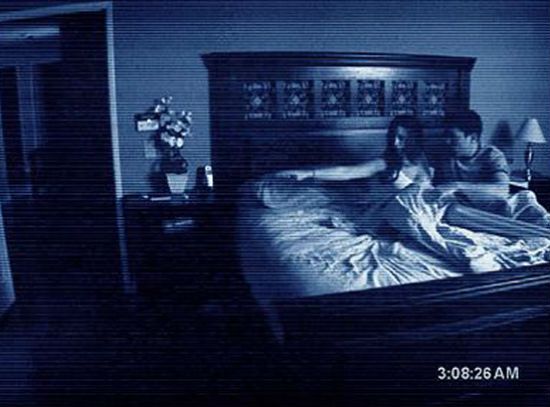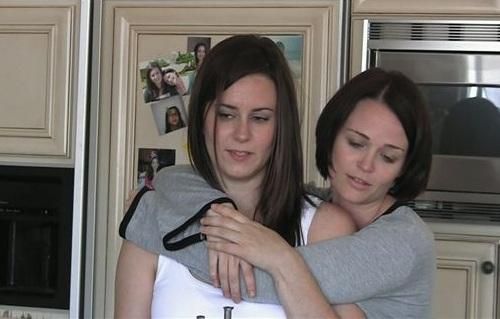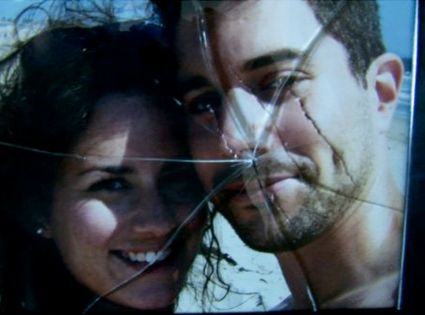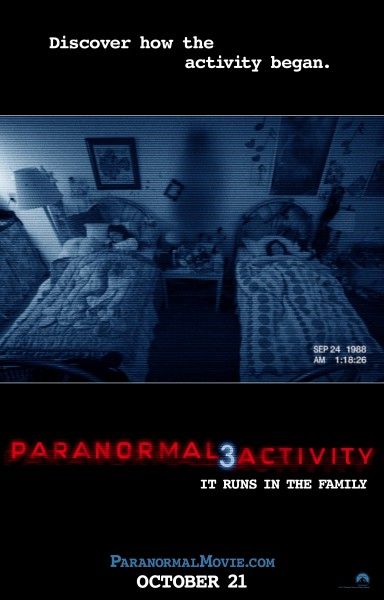There is a lot Paranormal Activity grand maestro Oren Peli won’t talk about. He won’t talk about his long delayed Area 51. He won’t talk about any hypothetical projects or anyone he wants to work with in the future. He won’t give any specifics on his new TV series, The River. And he professes that he has no idea what Paranormal Activity 4 will look like. With this in mind, it is no great shock to announce that a recent afternoon tea with Peli, as well as Christopher Nicholas Smith, Chloe Csengery and Jessica Tyler Brown (all of Paranormal Activity 3) and Micah Sloat and Katie Featherston (stars of the original film) revealed no great secrets about the franchise’s future. Rather, much like the films themselves, it was an afternoon of looking back and filling in the holes and unanswered questions about what came before.
The players told us about the difficulty of faking amateur camerawork, why Steven Spielberg turned off the original film halfway through, how the production allows for scene ideas from literally everyone, where the original concept for Paranormal Activity 2 came from and much, much more. Read on for the top 20 things to know about our afternoon tea with the cast and crew of Paranormal Activity.
As I said in the intro, Peli - who fielded most of the questions during the 90-minute sit down – is a man of few words. But perhaps it is this tightlipped restraint that is at the center of his success. Unlike most Hollywood types who are all too happy to wax poetic about vapor movies, Peli falls silent at even the slightest whiff of a hypothetical. And yet he never comes off as calculating or obtuse. Much like the invisible demons in his films, he knows exactly the right moment at which to strike. If found footage has taught him anything, it is that timing is everything.
And while nearly every press junket features at least one anecdote about how, “The cast was like a family,” few ensembles can boast the sweet-natured paternal feeling of Smith’s interactions with his on-screen daughters. While Csengery and Brown are both eminently charming and poised, they are still just little girls and it is impossible to coach a child on how to deal with a 90-minute interview with two-dozen participants and no scripted questions. Though there were only a few queries aimed directly at Smith, he still made a point to stop talking about himself in order to give the girls a chance to speak and to make them feel included.
In fact every one of the participants seemed very excited to be there. Featherston and Sloat still carry the wide-eyed demeanor of actors who can’t believe they’re suddenly famous, likely a residual effect of the long gestation between shooting and releasing the original film.
Even if you don’t like found footage horror, it is difficult to not warm to this motley crew and their Horatio Alger-style success story.
- There is no chain of command on a Paranormal set, everyone is allowed to pitch ideas. Like in most films, some scenes come courtesy of the directors and credited writer, while others come from the cinematographer or producers. But unlike most film sets, grips, dolly operators and production assistants are also encouraged to throw out concepts.
- Peli likes the style of the Paranormal films because the low budgets mean that if and when they have an idea, they can shoot it the next day, whereas a larger film would require endless meetings with executives and second and third guessing: “For example, we’re in a meeting and somebody comes up with an idea for a new scene,” said Peli. “We shoot it the next day. If it’s very complicated, maybe it takes two days to set it up. Then the next day it’s in the cut and we watch it and see, ‘Is it working?’ if it is, then cool, we have a new scene. If not, we go back to the drawing board and figure out something else to do instead.”
-
Paramount is very involved in the development of the Paranormal films, but generally stays off the set: “If we asked for money to do this amazing new effect of people flying around or whatever, it probably cost less than lunch on the set of Transformers 3,” said Peli. “So it was like peanuts for the studio.”
- Peli was absent for most of the development of Paranormal Activity 2, but was on set almost every day of the shoot. Conversely, he was involved with everything from concept to casting for Paranormal Activity 3, but was busy with other projects during the shoot.
- Peli turned down several Straight-to-DVD offers for the original film. It was three years between production and the release of the first film.
- On Paranormal Activity 4: “We have some ideas,” said Peli.
- The original idea for focusing on Katie’s sister in Paranormal Activity 2 came from Saw VI director, Kevin Greutert, who was briefly attached to direct the film before being pulled back to helm Saw 3D.
-
Part of the original inspiration for Paranormal Activity came from Peli’s fascination with reality television. However, he will not say if he has any plans to produce a reality TV series presently.
- Peli does not mind seeing other found footage films hit theaters. He recognizes that he did not invent the genre and feels like he was just in the right place at the right time and that this type of filmmaking was going to hit the mainstream sooner or later because of the influence of reality TV and YouTube: “In many cases I actually don’t think we deserve that much credit…or blame, depending on your point of view,” said Peli. “I think The Fourth Kind was already in development when we were shooting the first movie, as well as other movies. Personally, I don’t have any strong feelings about it one way or the other. If the movie is released and it is a good movie and people enjoy it, that’s great. If people feel like it has some similarities with Paranormal Activity, that’s cool with me. I don’t think we invented the genre, there was Blair Witch before blazing the trail and there have been a lot of other great found footage movies […] I kind of wonder if, without Paranormal Activity, if there still wouldn’t have been another resurgence in found footage movies because, especially with reality TV, it’s so much in the forefront of the audiences…and YouTube. […] I feel like it might have happened anyway and we were just lucky enough to be in the right place at the right time.”
-
Neither Csengery, nor Brown was allowed to watch the previous entries in the series before beginning work on Paranormal Activity 3: “I’ve seen parts of the movie,” Said Csengery. “But not the last fifteen minutes.” Brown added, “I got to see the movie right before I left [to come here] today, except… the scary parts.” Csengery continued, “I had heard of the movies before, but I was never allowed to see them, so [when I got the role, my mother] said that they were horror movies, sort of like, on the edge of your seat, you don’t know what’s going to happen next. Like, you’re sort of waiting and waiting and waiting and then something happens… and it’s not scary." [Massive laughter] “No! No! No! Not like that! Not like that! No! No! You think something’s going to happen and it’s going to be scary, but then it isn’t. and then you think something isn’t going to be scary and it is!”
- Both girls watched The Last Unicorn as research for their roles in the film.
- Sloat and Featherston hid out across from the premiere screening of the original Paranormal Activity because they wanted to see the lines but were both still pretending to be dead.
-
Before beginning work on the original film, Sloat had experience as a cameraman from running his college TV station. Peli had to coach him on being less professional with his framing, but later found that Sloat’s steady camerawork held the movie together: “What ended up happening as we were shooting was, he would be operating the camera and he was doing too good of a job,” said Peli. “I was looking at the footage and it looked like very professional. And I kept telling him, like, you gotta do a worse job.”
- The camera seen on screen during Paranormal Activity 3 is actually a tiny Hi-Def camera hidden inside the body of a VHS camcorder. For the first few weeks of shooting Smith did not have a viewfinder to see what his footage would look like: “When I was shooting, I couldn’t see,” said Smith. “I would look into the viewfinder – and it was really for shots that would catch me in the mirror – and I would look into the viewfinder and couldn’t see anything really. So what they had to do was they built, or they put in a screen, a little monitor in the viewfinder that was transmitting the video that it was recording in the body of this old VHS tape into this monitor. So I was basically watching a little monitor in the viewfinder. And it was like, week six when they figured that out.”
- Very little set dressing was done on the house from Paranormal Activity 3: “We would walk into [some of the potential locations] and it would be like they were frozen in the 80s,” said Peli. “We wouldn’t even need to do too much to them. So, sometimes you get lucky. […] We didn’t want to throw the 80s thing in your face too much. We didn’t want it to make it hugely like, ‘Look, it’s the 80s!”
-
On the future of the franchise: “Usually we do it one at a time,” said Peli. “But when we were working on the second one, we saw that there was a mythology emerging and we figured, let’s kind of build on it and plant some seeds so that, you know, depending on the direction of the third one, if we were ever lucky enough to do a third one, we’d have options to go forward in time or backward in time and either explore the mythology more and expand on it or keep going forward.”
- On the sound in the films: “There is no set rules,” said Peli. “Whenever we can, we try to do a lot of stuff on set so that the actors will have something to react to. But a lot of work is done in post too. Sometimes it’s to enhance what he have there, sometimes it’s to add little things.”
- On the limitations of the found footage genre: “Sometimes it kind of creates something else which is kind of even more creative,” said Featherston. “For instance, in the first one Micah and I had an argument at some point and I tell him to turn off the camera. And it just didn’t make sense for our relationship for him to keep filming. So we turned off the camera and then picked it back up and he has that silly apology or whatever.”
- On the filming style of a Paranormal movie: “We shoot for a couple of weeks, and Chris can tell you how much fun that is,” said Peli. “And then we put everything on hold for a week or two and say, ‘Let’s reshoot that whole first act again.’”
- On having Spielberg watch your movie: “The first Spielberg related call I had was, I got a call from the president of production at Dreamworks,” said Peli. “And he was telling me that, ‘You know, I think we should release it theatrically. We just need to work it out with the other people in the studio.’ So he calls me – and this was already pretty unusual because I’m just sitting in my house and I’m having the president of production calling me – and he’s telling me, ‘We really like the movie. We really want to release it. We just had to get the opinion of one other person. So yesterday Steven Spielberg watched the movie.’ And I’m already about to have a heart attack. ‘But he stopped it halfway through…’ And my heart stopped. And then he continues, ‘…Because he got too scared. And he finished watching it this morning and he loved it and we’re going to release it.’”

